Intellectual disability and oral care
Intellectual disability and oral care
Dental care for people with intellectual disabilities
Everyone benefits from a healthy mouth. With a healthy mouth you can eat and drink well. A fresh mouth also looks nice. People with intellectual disabilities are more likely to have problems in the mouth. Motor skills are often weak or completely limited. In the mouth, this manifests itself, for example, in flabby lip, tongue and cheek muscles. But abnormal tooth position, muscle tension, dental damage due to falling or bumping (epilepsy) or nutrition can also cause problems in the mouth. With good oral care you keep the teeth and gums of your child or client healthy. Different ages have different mouth problems. Whether you are brushing the teeth of a child or an adult with an intellectual disability, you will encounter dilemmas to a greater or lesser extent. Here you can read about the most common problems and find solutions for good oral care.
Dental plaque and cavities
Dental plaque is a white-yellowish layer that is difficult to see. It arises on and between the teeth and on the transition to the gums. Dental plaque contains bacteria. These bacteria convert carbohydrates, such as sugar and starch from food and drinks, into acids in the mouth. Those acids cause cavities (caries) in the teeth.
Dental plaque and inflamed gums
Healthy gums are pink, fit tightly around the teeth and do not bleed when the teeth are brushed. Red, swollen or bleeding gums usually indicate inflamed gums. If you don't properly remove the plaque on and between the teeth, the bacteria in the plaque will cause the gums to become inflamed. Dental plaque that is not removed can harden and calcify into tartar. New plaque easily adheres to tartar. This is how the gums become more and more inflamed. The inflammation can even affect the underlying jaw bone. Severe gum problems can lead to tooth loss.
Cavities and gingivitis are infectious diseases that affect both oral and general health.
How do you remove dental plaque?
Brushing your teeth is the basis of good oral hygiene. It is a meticulous job and certainly not easy. Brushing your teeth is probably too difficult for your child or client. Your help is needed for this. But many children or clients often turn their heads or push the brush away with their tongue. For example, they bite the brush, retch, have tight cheeks, lips and tongue, clench the jaws, have severe bleeding gums and pain reactions or otherwise resist. Good posture and the right tools make brushing your child's or client's teeth easier. Brush the teeth twice a day carefully and not too vigorously. Use the cleaning instructions for this. A good brushing session takes two minutes. So take your time! Choose a time of the day when you can pay attention to your child or client's oral care, preferably in the morning after breakfast and in the evening before going to sleep.
The Ivory Cross advises brushing the teeth for two minutes twice a day, but realizes that this is not feasible in all situations. Brushing your teeth carefully once a day is better than twice a day. Ask your dentist or dental hygienist for other tips and advice for brushing your child's or client's teeth.
See also the Cleaning Poster This is how you brush your teeth!
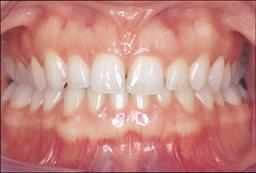
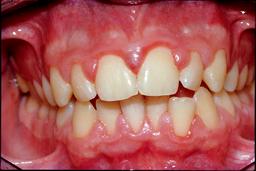
Choose a good toothbrush
Choose an electric toothbrush with a small brush head. Electric toothbrushes remove more plaque than manual toothbrushes when used correctly. Your child or client must definitely get used to brushing with an electric toothbrush. Take two weeks for that. Is it also not possible to brush electrically after that period? Then choose a manual toothbrush with soft bristles and a small brush head. Adults' teeth can also be brushed with a children's brush, if this reduces resistance in your adult child or client. The following applies to all brushes: replace the toothbrush every three months or when the hairs start to stand apart.
Use fluoride toothpaste
Fluoride makes tooth enamel stronger and less soluble in acid. Therefore, use a toothpaste with fluoride. You can brush with fluoride toothpaste even if your child or client cannot rinse after brushing. Swallowing a little bit of toothpaste isn't a big deal. Sometimes it can be helpful to brush without toothpaste. Then, after brushing, apply some fluoride toothpaste to the teeth with your finger. This is how you apply fluoride to the teeth.
The basic fluoride advice reads:
- 0 and 1 year, from the eruption of the first teeth: brushing once a day with fluoride toddler toothpaste
- 2, 3 and 4 years: brush twice a day with fluoride toddler toothpaste
- 5 years and older: brush twice a day with fluoride toothpaste
- For all ages: all other forms of fluoride use in consultation with a dentist or dental hygienist
Your dentist or dental hygienist may advise the use of extra fluoride for your child or client.
Use a toothpick or brush between the teeth
You cannot properly clean the spaces between the teeth with a toothbrush alone. This applies to both a manual toothbrush and an electric toothbrush. Therefore, use a toothpick or brush for the spaces in between. A good toothpick is made of wood, triangular in shape with a flat side and a point. They can differ in thickness. You can use thicker stokers for larger gaps. For narrower spaces, choose a thinner variant. Interdental brushes also come in all shapes and sizes. Use a toothpick or interdental brush once a day if possible. Choose a suitable time yourself, for example in the afternoon when it is a bit quieter. Ask your dentist or dental hygienist which toothpick or brush is best to use on your child or client and ask for instructions. See also the instructions in this brochure.
And if brushing doesn't work?
Sometimes it is not possible to use a toothbrush. A piece of gauze or a finger toothbrush with fluoride toothpaste can be practical substitutes. If this form of brushing your teeth is also not possible, a rinsing agent or mouth spray based on chlorhexidine can offer a solution. This substance reduces the effect of harmful bacteria in the dental plaque. Always consult your dentist or dental hygienist before use and ask for instructions. The teeth can discolor due to the use of a product containing chlorhexidine.
To the dentist or dental hygienist
Take your child or client to the dentist or dental hygienist at least twice a year. The teeth will then be properly checked and you will receive guidance to keep your mouth healthy. Drastic treatments can thus be avoided. Is there pain? Don't put off a visit any longer and make an appointment. The dentist or dental hygienist can also indicate that he wants to increase the frequency of visits for your child or client. Not all dentists are experienced in treating people with disabilities. For example, they will refer you to a colleague or to a Center for Special Dentistry. You can get in touch with such a center via the Association for the Promotion of Dental Health Care for the Handicapped (VBTGG) and the Central Consultative Body for Special Dentistry (Cobijt). You need a referral letter from your general practitioner
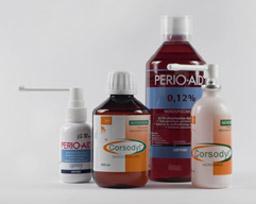

Instruction for correct brushing posture for people with intellectual disabilities
Correct brushing posture
Proper brushing posture is more important than you may think. Too often parents or supervisors stand in front of their child or client. But then you have little view in the mouth, you have no control over your child or client and you yourself are in a vulnerable position. Have your child or client sit and stand diagonally behind him. Fix the head and look into the mouth what you are doing. Press the cheek with your finger in your child's or client's mouth to the side and push the lip away with your thumb.
Is your child or client lying down? Then preferably choose his or her preferred position. For example, raise the head slightly using a rolled towel around his or her neck. Brushing teeth can increase the risk of choking in children and clients with a swallowing disorder. Brushing your teeth can also trigger a gag reflex. Brush their teeth without toothpaste. After brushing, apply a little fluoride toothpaste to your finger and 'grease' the teeth with it. Use an (electric) toothbrush and a toothpick or interdental brush. Client supervisors are advised to wear gloves for hygienic reasons.
Opening the mouth
If your child or client is unwilling or unable to open his mouth, arrange for mouth control. Bend the head slightly forward. This makes the mouth relax more easily. There are two ways: mouth control from the front (see photo) and from the side.
Mouth control from the front: Place your thumb of your left hand (other hand for left-handers) on the pad of the chin, your index finger on the cheek and your middle finger under the chin. Make sure your thumb does not touch the lower lip. Gently press the chin pad with your thumb in front and gently up with your middle finger. The mouth opens.
Mouth check from the side: Put your index and middle fingers of your left hand (the other hand for left-handers) around the chin. Place your index finger on the chin pad, with your middle finger extended underneath. Make sure your index finger does not touch the lower lip. Your thumb rests on your hand, not on the face. Gently press the chin pad with your index finger and gently lift with your middle finger. The mouth opens. Ask your dentist or dental hygienist for a demonstration.
biting sticks
If keeping the mouth open is very difficult, biting sticks and blocks such as those used by the dentist can sometimes help. There are biting sticks and cubes (of rubber and) of steamed beech wood. They do not give sharp splinters, even if they are chewed to pieces. You can get them through your dentist or dental hygienist. You can also ask them for advice on how to use it.
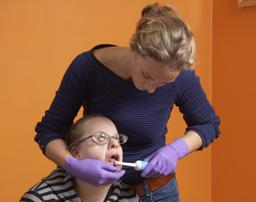
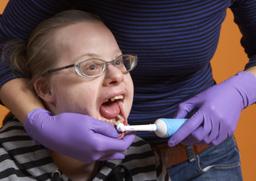


Oral problems in people with intellectual disabilities
People with intellectual disabilities are more likely to develop gum disease and tooth decay (cavities). This has a number of causes:
Power supply
Due to chewing and swallowing problems, people with intellectual disabilities often eat liquid, pureed or finely chopped, soft (tube) food. They also often keep food in the mouth for a long time. Soft foods reduce the natural self-cleaning effect of the mouth. Consumption of soft (tube) nutrition promotes the formation of dental plaque. Plaque, once hardened, becomes tartar. New plaque easily 'sticks' to tartar.
What to do with soft food
Oral hygiene is key here. Be sure to remove all plaque on a daily basis to prevent cavities and gum disease.
Decreased natural cleaning of the mouth
Not only soft food causes a reduced self-cleaning of the mouth. Stiff and flaccid paralysis of the mouth muscles, constant opening of the mouth and mouth breathing are also causes of reduced natural cleaning of the mouth.
What to do if the natural cleaning of the mouth is impaired
Here also applies: oral hygiene. Be sure to remove all plaque on a daily basis to prevent cavities and gum disease.
Sucking or sucking
Frequent sucking on a baby bottle or non-drip cup with sweet contents, such as fruit juice, syrup, drinking yoghurt and other dairy products, can affect the teeth. Because the teeth come into contact with sugars for a long time, there is a high chance of the development of so-called baby bottle caries.
What to do if you suck or suck
Limit the amount of sweet drinks. As an alternative, if possible, give water or regular tea without sugar. Let your child or client drink sweet drinks in one go. If possible, use a regular cup, for example with a straw. In the evening and at night, drinking from a baby bottle with sweet content is even more harmful. At night, the saliva can hardly repair the acid attacks on the teeth. Drinking water from a feeding bottle (at night) is not harmful.
Reflux and rumination of food
Stomach acid is extremely acidic. Acids that enter the mouth attack the tooth enamel. This form of irreversible tooth wear is called dental erosion. Some clients return stomach contents to the mouth (rumination or rumination) or experience spontaneous food reflux (reflux). In reflux, stomach acid flows back up the esophagus into the oral cavity due to a malfunction of the sphincter between the esophagus and the stomach.
What to do with reflux or rumination
Acid-reducing medicines can help. Sometimes reflux surgery may be necessary. Adjusting the diet can also have an effect. For nutritional advice, please contact the dietician.
Disorder in the substitution sequence
Children are usually born toothless. A child changes its milk teeth between the ages of six and twelve. At least that's what it says in the books. The switching period may be different for your child or client. Children with intellectual disabilities often have a small jaw. As a result, the teeth do not fit in it. Often a child does not change all his teeth, but only partially, while the permanent teeth have formed. The times at which the teeth come through can also differ.
What to do when exchanging
The enamel of the newly erupted teeth is still very porous and fragile. Brush the tips of the new teeth as soon as they erupt. When new molars come through, the gums often swell. That is normal. It can be painful, but don't worry. Visit the dentist regularly for a check-up.
Abnormal tooth position
Many people with an intellectual disability have an abnormality in the position, shape and number of teeth. If teeth are neatly lined up, you can clean them properly. That becomes much more difficult if they are skewed or, for example, behind each other. It's hard to get to with the brush. An abnormal tooth position usually has no consequences for the health of teeth and molars.
What to do with an abnormal tooth position
Extra attention to oral hygiene. Pay particular attention to the spaces between the teeth. Sometimes the dentist can improve an abnormal tooth position with braces or, for example, with implants. The dentist can also advise shortening the dental arch (pulling teeth) so that brushing your teeth becomes easier.
Use of medicines
Several medications have the side effect of inhibiting the salivary glands in the secretion of saliva. These are mainly medicines used in the treatment of high blood pressure (antihypertensives), heart rhythm disorders (digoxin, antiarrhythmics) or medicines such as antidepressants, sleeping pills and diuretics. The drugs usually do not affect the salivary glands themselves, but only inhibit saliva secretion. Saliva has a lubricating effect when speaking, chewing and swallowing. With the help of saliva we can move more easily with our cheeks, tongue and lips. With saliva we moisten our food in such a way that we can swallow it painlessly. Saliva also moistens the oral mucosa, preventing dehydration. In addition, it has a cleansing effect on teeth, molars and the oral mucosa. In addition, saliva inhibits the functioning and growth of bacteria and fungi in the mouth, preventing mouth infections. If your child or client does not have enough saliva, plaque builds up faster than normal. This causes holes to form more quickly. This especially happens when your child or client regularly eats or drinks sugary foods. In a dry mouth, the formation of dental plaque and cavities mainly occur along the edges of the gums. This can also inflame the gums. Medication use can also have other consequences, such as gum growth (medicines for epilepsy), discoloration of the teeth (chlorhexidine) and the production of too much saliva, i.e. drooling (painkillers, antipsychotics, anti-stroke drugs).
What to do with a dry mouth
If medication is the cause of your child's or client's dry mouth, talk to your GP or specialist about whether you can adjust the type of medication, the dosage or the time of administration. You can stimulate your child or client's saliva production by giving him food that he has to chew well. Think of solid brown sandwiches, carrots or sugar-free chewing gum. The release of saliva can also be enhanced by eating slightly acidic foods, such as fruit or cucumber. This often does not work or does not work sufficiently for people who have suffered from Sjögren's syndrome for a longer period of time or who have had radiation therapy in the head or neck.
What to do with gum growth
Tell the dentist or dental hygienist that your child or client has started taking the medication. Right from the start, extra good oral hygiene is important. Then you can prevent gum growth in your child or client. The gums grow mainly in places where dental plaque is present. Removing that dental plaque is therefore extra important. Especially since brushing away in those places is becoming increasingly difficult. Red, swollen and bleeding gums are inflamed. The inflammation never goes away on its own. Good oral hygiene is extra important. Visit the dentist or dental hygienist regularly to have your child's or client's mouth cleaned.
What to do with drooling
Eating sugary foods increases saliva production. Therefore, give your child or client as little of it as possible. Close your child's or client's mouth as much as possible. In case of persistent complaints, contact your general practitioner, dentist or speech therapist.
Tooth injury
Children and adults with epilepsy can fall at an unexpected time. A person who falls on their face risks breaking or losing their teeth. People who have difficulty walking, or otherwise have limited motor skills, often walk more unstable and are therefore more likely to suffer dental injuries. Then there is a group of patients who self-harm. They suffer from self-mutilation. Self-mutilation can lead to tooth damage.
What to do with a dental injury
If the tooth is broken, loose or out of the mouth: go to the dentist immediately. Keep (the broken part of) the tooth wet in milk.
Habits
Thumbs in a mouth with permanent teeth is bad for the position of the teeth. Sucking on cloths, teats and fingers can also lead to an abnormal tooth position. People with intellectual disabilities often suck excessively, which changes the position of the teeth. An abnormal tooth position can make oral hygiene more difficult. But nail biting and teeth grinding (bruxism) also increase the risk of tooth wear.
What to do with bad habits
Try to unlearn the deviant habits in your child or client. Stimulate the positive behavior. Ask your dentist, dental hygienist, speech therapist or remedial educationalist for advice.
Down syndrome
People with Down syndrome often have floppy tongue and mouth muscles. These make it difficult to swallow, eat, drink and speak. As a result, the self-cleaning function of the mouth works less well. More dental plaque is the result. People with Down syndrome breathe more through the mouth. A dry mouth is the result. As a result, the protective effect of the saliva is limited. Due to the reduced resistance, these people are more likely to contract serious (gum) infections. The roots of teeth and molars of people with Down syndrome are also often short. In case of gum disease, they can therefore become loose earlier.
What to do with Down syndrome
Promote good oral habits. Teach your child or client to keep the tongue in the right place as much as possible, so as much as possible behind the front teeth. Start this early. Proper use of the tongue stimulates you more with breast feeding than with bottle feeding. A speech therapist can give you explanations and exercises for the correct use of the tongue. Try to encourage breathing through the nose in your child or client. You can do that by consistently closing his mouth when your child or client is asleep.
Cleaning of prostheses and implants in people with intellectual disabilities
Many adults with intellectual disabilities wear dentures (dentures). Nowadays, treatment with implants is also possible for people with intellectual disabilities. An implant is a type of artificial root that is screwed into the jaw on which the dentist can attach a crown (tooth or molar), bridge (more teeth or molars) or prosthesis (dentures). In both situations, good oral hygiene is very important to prevent infections and inflammation.
Cleaning the denture
You must clean your client's prosthesis thoroughly every day, just like you would your own teeth. If you do not clean the dentures regularly, food residue will remain. Both on the dentures and underneath. If you don't remove it, the gums can become inflamed. Preferably rinse the denture and mouth with water after each meal. Remove food residues on the prosthesis and in the mouth. Use a special denture brush, for example from Lactona or Oral-B, to thoroughly brush the denture and remove plaque. Do not use toothpaste for this. It can rub too much. Use water and a mild liquid soap. Clean dentures always feel smooth. Don't let the smooth teeth slip out of your hands during cleaning. It will break. To be on the safe side, first fill the sink with water and clean the dentures above it.
Soak the dentures in vinegar overnight once a week. This prevents the formation of tartar on the dentures. Then brush the dentures well and rinse them with water. Never put the dentures in hot water and certainly do not use bleach or abrasives. If necessary, ask your client's practitioner for advice.

Also clean your client's mouth
In addition to the prosthesis, also clean the mucous membrane on which the dentures rest: the jaws, the palate and the transition from the jaw to the cheeks. Otherwise annoying inflammations can occur. And now also applies: prevention is better than cure. Massage the mucous membrane at least once a day with a soft toothbrush and water. Pay extra attention to the palate. Always start on the outside in the upper jaw. Your child or client gets used to this the easiest and gives the least resistance. Move the brush a little at a time. Then brush the inside of the upper jaw. Then you brush the outside of the lower jaw, followed by the inside of the lower jaw. If your child or client gags easily, it is best to brush from the center to the side and back. Also read the information about the correct brushing posture and methods for opening the mouth.
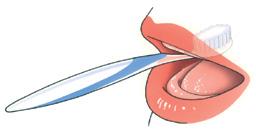
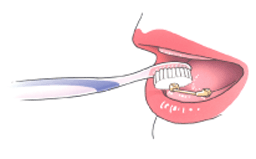
Take the dentures out at night
At night you should leave the prosthesis out of your child's or client's mouth to keep the mucous membrane on which the prosthesis rests healthy. After cleaning, store the prosthesis in a container of clean water. Brush the denture again in the morning before putting it back in your child's or client's mouth.
Denture cleaners
There are various denture cleaners on the market. The hydrogen peroxide it contains has an antibacterial effect. A cleaning agent inhibits or removes discolorations from coffee, tea, wine and tobacco and is refreshing. A cleaning agent does not dissolve dental plaque. Brushing is necessary for this. Excessive use of these cleaning agents can damage the prosthesis. The dentures may fade and the surface may become rougher. A denture cleaning tablet can be life-threatening for your child or client. Damage to the esophagus can also occur if your child or client mistakes the tablet for a candy. It is therefore recommended to use water and liquid soap daily and vinegar once a week.
Cleaning implants
An implant under a crown or bridge is anchored in the bone. It is very important that you clean the transition from the crown or bridge to the gums well. Carefully brush this area with a soft (electric) toothbrush with fluoride toothpaste, using toothpicks or interdental brushes. Oral hygiene is very important with implants, also for people with disabilities. With poor oral hygiene, your child or client can lose their implant.
Implants that serve as pillars under an overdenture should be cleaned with a soft toothbrush and toothpaste, interdental brushes and/or (super) floss. Brush the part of the implant that protrudes above the gums twice a day. Pay extra attention to the transition from the implant to the gums. Clean the area under the splint with brushes and/or superfloss as instructed by the dentist or dental hygienist. On the prescription of the dentist or dental hygienist, you can apply chlorhexidine gel around the implant once a day and place the denture over it.
If you do not remove food residues and dental plaque around the implants, the gums will become inflamed. As a result, they eventually lose their grip, become loose and can cause pain. Also view the correct brushing posture, methods for opening the mouth and brushing instructions.
For more information about oral and dental problems, oral care and oral health of people with an intellectual disability, please contact or at:
- Association for the Promotion of Dental Health Care for the Disabled (VBTGG) provides information about dental care for people with disabilities.
- Central Consultation Special Dentistry (COBIT) provides an overview of the Centers for Special Dentistry established in the Netherlands.
- Dutch Association for Pediatric Dentistry (NVvK) provides an overview of pediatric dentists working in the Netherlands.
- The Dutch Association for Speech Therapy and Phoniatry (NVLF). The website informs about the work of the speech therapist: developing and, where necessary, restoring oral functions. Disorders
in the mouth can be caused by neurological disorders or diseases. - LFB is an interest group of people with an intellectual disability that stands up for the interests of people with an intellectual disability.
- Kiesbeter.nl is a public healthcare portal intended for all adult residents of the Netherlands who have questions about healthcare, healthcare insurance and health. Care for the disabled in the Netherlands can be searched for and compared on the basis of care, services and accommodation provided. The site also provides general information about disability care.